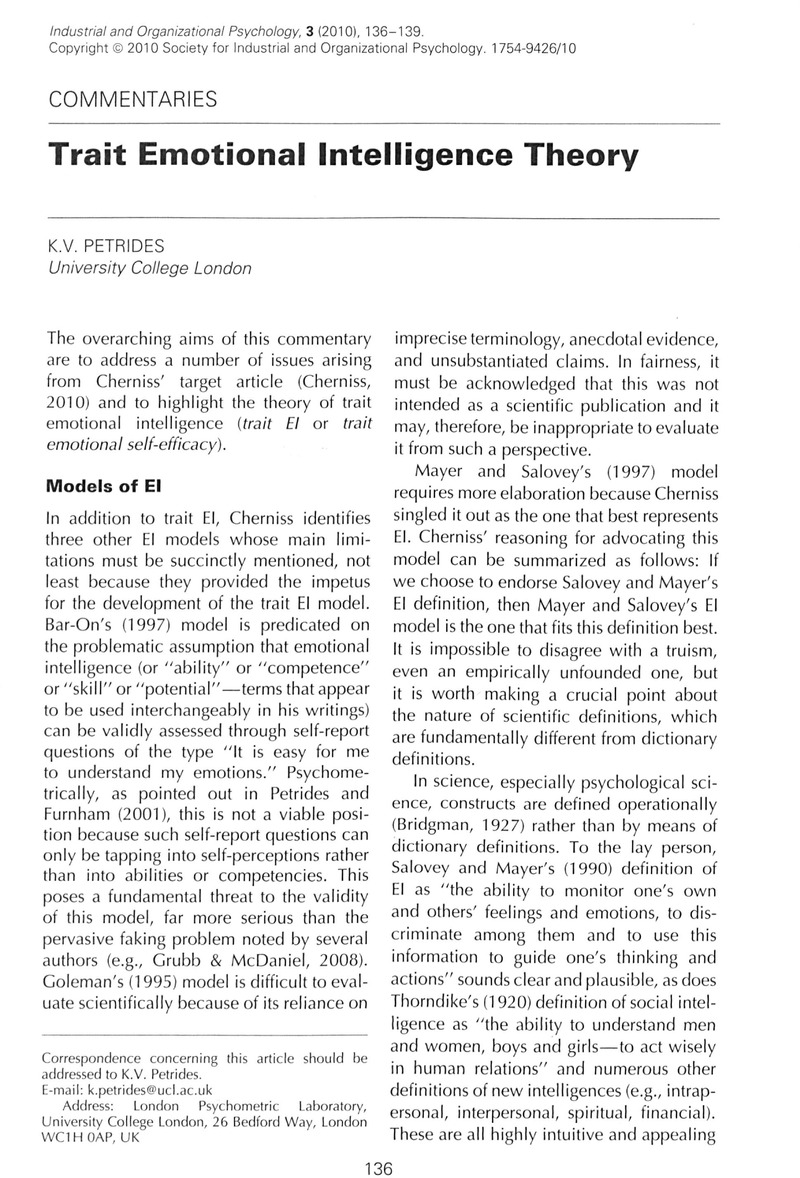Crossref Citations
This article has been cited by the following publications. This list is generated based on data provided by Crossref.
Cherniss, Cary
2010.
Emotional Intelligence: New Insights and Further Clarifications.
Industrial and Organizational Psychology,
Vol. 3,
Issue. 2,
p.
183.
Smollan, Roy
and
Parry, Ken
2011.
Follower perceptions of the emotional intelligence of change leaders: A qualitative study.
Leadership,
Vol. 7,
Issue. 4,
p.
435.
Arora, Sonal
Russ, Stephanie
Petrides, K. V.
Sirimanna, Pramudith
Aggarwal, Rajesh
Darzi, Ara
and
Sevdalis, Nick
2011.
Emotional Intelligence and Stress in Medical Students Performing Surgical Tasks.
Academic Medicine,
Vol. 86,
Issue. 10,
p.
1311.
Lindebaum, Dirk
and
Cartwright, Susan
2011.
Leadership effectiveness: the costs and benefits of being emotionally intelligent.
Leadership & Organization Development Journal,
Vol. 32,
Issue. 3,
p.
281.
Libbrecht, Nele
and
Lievens, Filip
2012.
Validity evidence for the situational judgment test paradigm in emotional intelligence measurement.
International Journal of Psychology,
Vol. 47,
Issue. 6,
p.
438.
Nikoopour, Jahanbakhsh
Farsani, Mohammad Amini
Tajbakhsh, Mohammad
and
Kiyaie, Seyedeh Hoda Sadat
2012.
The Relationship between Trait Emotional Intelligence and Self-efficacy among Iranian EFL Teachers.
Journal of Language Teaching and Research,
Vol. 3,
Issue. 6,
Fukuda, Eriko
Saklofske, Donald H.
Tamaoka, Katsuo
and
Lim, Hyunjung
2012.
Factor Structure of the Korean Version of Wong and Law’s Emotional Intelligence Scale.
Assessment,
Vol. 19,
Issue. 1,
p.
3.
Siegling, Alexander B.
Vesely, Ashley K.
and
Saklofske, Donald H.
2013.
Advancing the trait EI content domain: Further evidence for the distinctiveness of interpersonal facets.
Personality and Individual Differences,
Vol. 54,
Issue. 1,
p.
81.
Føllesdal, Hallvard
and
Hagtvet, Knut
2013.
Does emotional intelligence as ability predict transformational leadership? A multilevel approach.
The Leadership Quarterly,
Vol. 24,
Issue. 5,
p.
747.
Fox, Matthew
2013.
Putting Emotional Intelligence to Work.
Journal of the Academy of Nutrition and Dietetics,
Vol. 113,
Issue. 9,
p.
1138.
McCleskey, Jim
2014.
Emotional intelligence and leadership.
International Journal of Organizational Analysis,
Vol. 22,
Issue. 1,
p.
76.
Ko, Flora S.L.
and
Siu, Andrew M.H.
2014.
Validation of a Chinese version of the Assessing Emotions Scale for measuring the emotional intelligence of Chinese adolescents.
International Journal on Disability and Human Development,
Vol. 13,
Issue. 1,
p.
79.
Sanchez-Ruiz, Maria-Jose
and
Hernández-Torrano, Daniel
2014.
The complex relationship between creativity and affect / La compleja relación entre creatividad y afecto.
Estudios de Psicología,
Vol. 35,
Issue. 2,
p.
239.
Hubscher-Davidson, Séverine
2014.
Emotional Intelligence and Translation Studies: A New Bridge.
Meta,
Vol. 58,
Issue. 2,
p.
324.
Libbrecht, Nele
Beuckelaer, Alain De
Lievens, Filip
and
Rockstuhl, Thomas
2014.
Measurement Invariance of the Wong and Law Emotional Intelligence Scale Scores: Does the Measurement Structure Hold across Far Eastern and European Countries?.
Applied Psychology,
Vol. 63,
Issue. 2,
p.
223.
McCleskey, Jim A.
2015.
New Ways of Studying Emotions in Organizations.
Vol. 11,
Issue. ,
p.
271.
Goldring, Ellen
Cravens, Xiu
Porter, Andrew
Murphy, Joseph
and
Elliott, Steve
2015.
The convergent and divergent validity of the Vanderbilt Assessment of Leadership in Education (VAL-ED).
Journal of Educational Administration,
Vol. 53,
Issue. 2,
p.
177.
Perera, Harsha N.
2015.
The Internal Structure of Responses to the Trait Emotional Intelligence Questionnaire–Short Form: An Exploratory Structural Equation Modeling Approach.
Journal of Personality Assessment,
Vol. 97,
Issue. 4,
p.
411.
Keefer, Kateryna V.
2015.
Self-Report Assessments of Emotional Competencies.
Journal of Psychoeducational Assessment,
Vol. 33,
Issue. 1,
p.
3.
Scalco, Andrea
2015.
Trends in Practical Applications of Agents, Multi-Agent Systems and Sustainability.
Vol. 372,
Issue. ,
p.
237.



